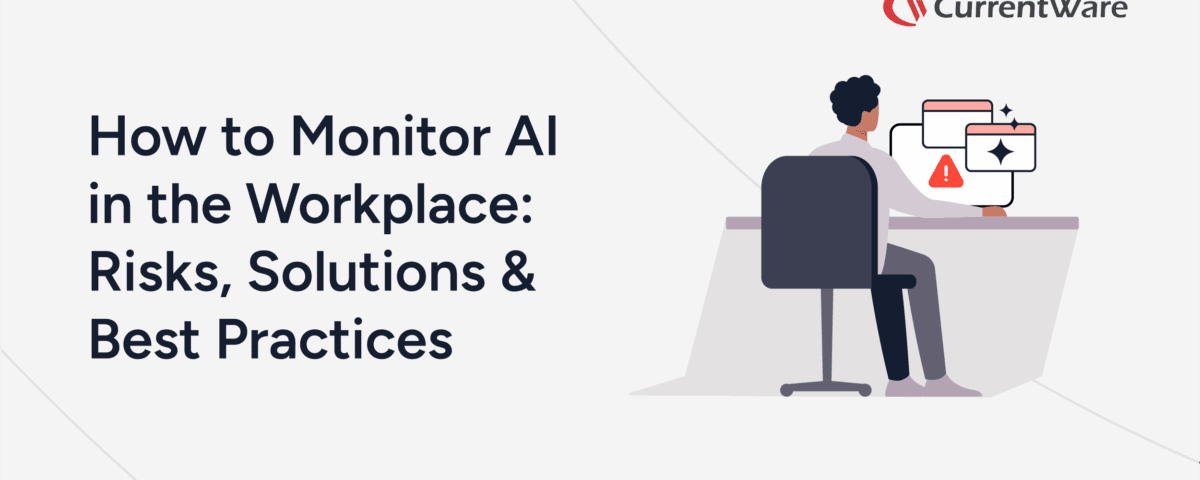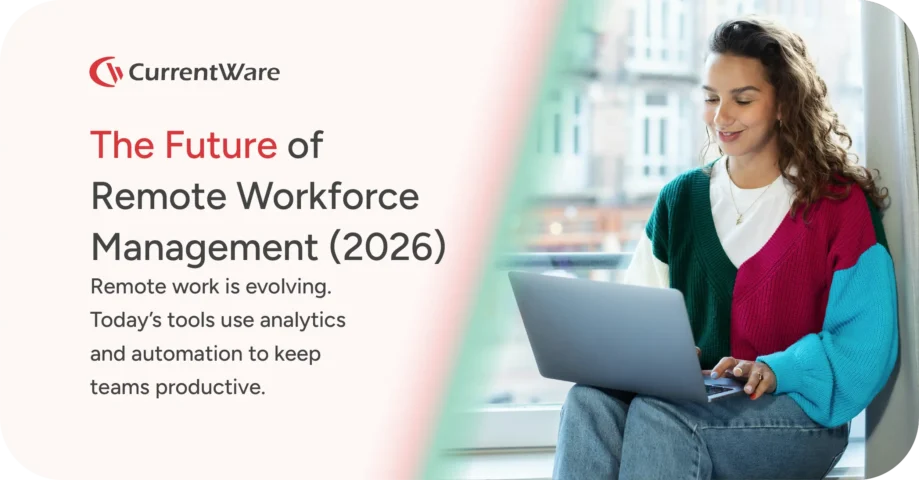How to Monitor AI in the Workplace: Risks, Solutions & Best Practices

Table of Contents
- 1: The Invisible Colleague: Understanding Shadow AI in the Workplace
- 2: Productivity vs. Peril: The Dual Nature of Employee AI Use
- 3: Flying Blind: Why Traditional Monitoring Falls Short
- 4: Seeing the Unseen: Granular AI Usage Monitoring with CurrentWare
- 5: From Monitoring to Governance: Implementing AI Best Practices
- 6: The Path Forward: Turning Shadow AI into Strategic Advantage
- 7: Conclusion: Turn AI from a Hidden Risk into a Visible Asset
- 8: Frequently Asked Questions
The rise of AI tools like ChatGPT, Gemini, Midjourney, and Copilot is reshaping workplaces, with employees adopting these tools to boost productivity and innovation. However, this rapid adoption often occurs without IT oversight, creating Shadow AI - a growing challenge for businesses. This guide explores how to monitor employee AI activity responsibly using CurrentWare's BrowseReporter and AccessPatrol, mitigate risks like data leaks and regulatory violations, and transform AI into a strategic asset.
The Invisible Colleague: Understanding Shadow AI in the Workplace
AI tools are as accessible as a web browser, requiring no IT setup or approvals. This ease of use fuels an unseen revolution in employee workflows but introduces significant Shadow IT risks that businesses must address to ensure AI compliance and data security.
Start minimizing your software costs today.
Are you ready to start tracking software usage and start saving time and money?
The Unseen Revolution: How Employees Are Adopting AI
Employees across marketing, development, and customer service are leveraging AI to perform tasks more efficiently and accomplish functions that would otherwise take much longer:
• Summarize lengthy reports at high speed, producing concise outputs for quick review
• Draft professional emails and blog posts, generating written outputs efficiently
• Generate or debug code for faster development, with code outputs ready for deployment
• Create marketing visuals with tools like Midjourney, resulting in high-quality visual outputs
• Enhance customer response times with AI-crafted replies, ensuring consistent communication outputs
Also Read: What is Employee Monitoring? – Definition, Tips, and Techniques
The "Shadow AI" Workforce: A Blind Spot for Businesses
Productivity vs. Peril: The Dual Nature of Employee AI Use
As AI systems become more advanced and integrated, their growing complexity makes effective oversight and monitoring increasingly challenging. Monitoring AI performance, accuracy, and reliability is essential to ensure it is used as intended and consistently meets business objectives.
These productivity gains make AI a valuable ally, but workplace AI monitoring is critical to prevent misuse.
Data Exfiltration: Protecting Sensitive Information
When employees input sensitive data, customer PII, financial records, or proprietary code, into public AI tools, they risk data exfiltration. Many platforms retain inputs for model training unless opted out, potentially leaking data permanently. This can cost businesses millions in recovery efforts or a lost competitive edge.
Compliance Nightmares: Navigating Regulations (GDPR, HIPAA, etc.)
Using unvetted AI tools with regulated data can trigger compliance violations under:
• GDPR: Fines up to €20 million or 4% of annual revenue for mishandling EU data.
• HIPAA: US healthcare regulations mandate secure data handling, with penalties reaching $1.5 million annually.
• SOX/PCI-DSS: Financial and payment card regulations demand strict controls.
A single misstep, like pasting regulated data into a public AI model, can lead to legal action or loss of customer trust. Rigorous testing of AI tools and processes is essential to validate that they meet regulatory and ethical standards before deployment.
Intellectual Property Drain: Safeguarding Your Secret Sauce
AI models like ChatGPT may use input data to improve algorithms unless opted out. If employees share trade secrets, this intellectual property drain could enhance tools used by competitors, undermining your company’s edge.
Also Read: Employee Monitoring Software for Productivity & Security
Flying Blind: Why Traditional Monitoring Falls Short
The Limitations of Standard Web Filters and Network Monitoring
| Feature | Traditional Web Filters | CurrentWare |
| Blocks AI domains | ✅ | ✅ |
| Tracks AI usage by user/team | ❌ | ✅ |
| Identifies specific tools (e.g., Midjourney) | ❌ | ✅ |
| Flags sensitive keyword inputs | ❌ | ✅ |
| Distinguishes productive vs idle use | ❌ | ✅ |
Legacy solutions like web filters or DNS monitoring can:
• Block entire domains (e.g., OpenAI.com)
• Log basic IP-level traffic
However, they cannot:
• Track specific actions within AI platforms
• Differentiate between productive and risky monitor ChatGPT use
• Provide granular insights into usage patterns
This creates a black box of AI activity, making it impossible to assess Shadow AI risks.
The "Black Box" of AI Activity: A CISO's Challenge
CISOs face critical questions: Which AI tools are employees using? Who is using them? Are they handling sensitive data? Without specialized tools for AI usage tracking and AI activity monitoring, businesses are flying blind, unable to enforce AI compliance or mitigate data security risks. It is also essential to verify the accuracy and integrity of data and AI usage to ensure compliance and security.
Seeing the Unseen: Granular AI Usage Monitoring with CurrentWare
CurrentWare’s suite, including BrowseReporter and AccessPatrol, offers a robust solution to monitor employee AI activity and address Shadow AI. CurrentWare enables organizations to monitor AI tools in production environments after deployment, including the analysis of production data to detect shifts and maintain model performance. The platform supports continuous monitoring of AI systems to ensure ongoing performance and compliance. It provides tools to measure and analyze AI usage and performance, ensuring effective oversight through detailed analytics. Unlike generic tools that provide only basic logging, BrowseReporter provides AI-specific analytics and behavioral AI monitoring at the user and department level, deployable in hours for instant visibility. CurrentWare is also designed to provide essential oversight while respecting employee privacy, offering monitoring features that can be configured for visibility options, including stealth and transparent modes, to match organizational needs and compliance requirements.
CurrentWare: Your Partner in AI Usage Analytics
BrowseReporter delivers granular insights into AI usage in the workplace, effectively solving the “black box” problem with highly detailed reporting. You can schedule monitoring jobs to automatically track user activity and calculate detailed usage metrics, ensuring comprehensive analytics for your organization. With BrowseReporter, you can quickly compare usage patterns or datasets to identify anomalies or changes in AI activity.
Which AI Tools Are Being Used?
BrowseReporter tracks:
• Visits to AI platforms like ChatGPT, Claude, Midjourney, and Gemini
• Frequency and duration of usage
• Browser-level activity for web-based AI tools (e.g., specific URLs visited within an AI platform)
• Tracking individual instances of AI tool usage, including analyzing the outputs generated during each instance
This depth of AI activity tracking ensures no Shadow AI activity goes unnoticed.
Identifying Key Adopters and Departmental Trends
Built-in reports help:
• Identify heavy AI users (e.g., marketing vs. engineering)
• Monitor usage patterns to spot risks or opportunities
• Analyze the range of usage patterns and identify which features of AI tools are most frequently used
• Tailor governance based on team-specific needs
For example, a tech firm utilized BrowseReporter to discover that its marketing team heavily relied on Midjourney, allowing for targeted training to prevent data leaks.
Distinguishing Productive vs. Unproductive AI Use
BrowseReporter’s active vs. idle time metrics reveal whether AI use is:
• Work-related (e.g., drafting reports while actively typing or clicking within an AI tool’s interface)
• Excessive or unrelated to job functions (e.g., extended idle time on an AI platform detected by a lack of keyboard/mouse activity).
• Replacing human effort entirely
In addition to tracking activity, performance metrics such as precision and recall can be used to assess the effectiveness of AI usage in meeting business objectives.
This provides context beyond simple website visits, helping identify legitimate AI usage versus time-wasting or misuse. Consistency in monitoring results is crucial to ensure reliable and ethical AI operations.
Also Read: Best Practices for Employee Monitoring in 2025 (Free Guide)
How to Monitor AI Use in 5 Steps
• Define monitoring objectives → Clearly define what you want to monitor, such as performance metrics or specific AI tool usage, to establish a strong foundation for your monitoring process.
• Deploy BrowseReporter → Track AI tools & behavior, and configure monitoring settings to ensure you capture relevant data and alerts. Set up prompt monitoring for language models to track and evaluate prompt usage and effectiveness.
• Analyze usage trends → Identify top users & risks
• Draft an AI Acceptable Use Policy
• Use BrowseControl → Block risky uploads/platforms
• Enable keyword alerts → Catch data leakage in real-time
AI monitoring lays the foundation for governance, ensuring AI use aligns with organizational goals.
Crafting an Informed AI Acceptable Use Policy (AUP)
Using BrowseReporter insights, create an AI Acceptable Use Policy (AUP) that includes:
• Approved and prohibited AI tools
• Protocols for handling sensitive data
• Transparency and consent requirements (e.g., explicitly informing employees about monitoring to build trust and ensure buy-in).
• Escalation paths for violations
This ensures AI compliance while empowering responsible AI adoption by employees.
Identifying Power Users to Champion Best Practices
Leverage monitoring data to:
• Identify employees using AI effectively
• Leverage human judgment to evaluate and promote effective AI use
• Enlist them to develop training programs
• Position them as AI ambassadors to promote safe practices
Proactively Mitigating Risks with AI Control Tools
CurrentWare’s suite offers layered defenses for AI policy enforcement and data loss prevention. Control tools play a vital role in AI policy enforcement by ensuring system reliability, security, and regulatory compliance:
• BrowseControl: Block unauthorized AI platforms by URL or application executable name (e.g., completely prevent access to OpenAI.com or specific AI desktop applications like Midjourney) or restrict specific file uploads to specific cloud-based AI tools or general cloud storage services to prevent data exfiltration.
• BrowseReporter: Set keyword alerts for sensitive terms (e.g., “project Orion,” “customer database,” or “Q3 financial projections”) to flag potential sensitive data entry into public AI models, triggering immediate notifications to security teams.
• Device Control: Limit data transfers to external devices (USB drives, network shares) and prevent uploads to unapproved cloud storage or AI services by controlling network access to specific domains and blocking file extensions.
Regular monitoring and documentation are necessary to maintain ongoing security and compliance as AI systems evolve.
Also Read: How to Check Computer Activity on Any PC: Step-by-Step Guide
Conclusion: Turn AI from a Hidden Risk into a Visible Asset
Shadow AI is a growing challenge, risking data exfiltration, compliance violations, and intellectual property drain. With CurrentWare’s BrowseReporter and AccessPatrol, businesses gain visibility and control to transform AI in the workplace into a competitive advantage. By monitoring employee AI activity, crafting informed policies, and fostering responsible use, organizations can harness AI’s potential safely. Monitoring AI in the workplace is essential for maintaining security, detecting anomalies, and driving ongoing innovation. Illuminate the path to a secure, AI-powered future with CurrentWare.
Ready to take control of Shadow AI and unlock safe innovation? Explore CurrentWare’s solutions today and request a demo or free trial.
Frequently Asked Questions
- Title I (Wiretap Act): Prohibits the real-time interception of live wire, oral, or electronic communications.
- Title II (Stored Communications Act - SCA): Protects the privacy of communications that are in electronic storage, such as saved emails or files on a server.
- Title III (Pen Register Act): Regulates devices that capture metadata, like the phone numbers dialed or IP addresses contacted, without capturing the content of the communication.
Decoding AI in the Workplace: Key Terms You Need to Know
• Shadow AI: Unauthorized use of AI tools by employees without formal oversight.
• Data Exfiltration: Unauthorized transfer of sensitive data to external systems.
• Acceptable Use Policy (AUP): A company policy outlining how AI and IT tools can be used responsibly.
• Idle vs. Active Time: Metric showing whether employees are actively engaging with a tool or passively using it.
• Generative AI: AI tools that produce content such as text, code, or images.
• Features: Individual data attributes used in AI models. Monitoring features includes tracking their data distributions, importance, and contributions to detect drift or changes that may impact model performance.


